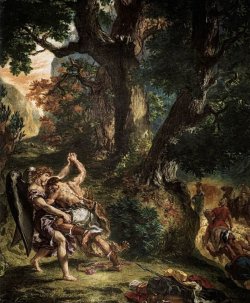|
Vicar's Musings for Easter 65 May, 2013 This week our Regional Bishop, Philip Huggins, invited all the priests and deacons of the Northern and Western Region to Queenscliff for our annual clergy conference. Fr Samuel and I attended; it was a very worthwhile gathering, with the Rev'd Dr Graeme Garrett as keynote speaker (you may recall that he launched Bishop Graeme and Jonathan Rutherford's book). The opening keynote address was based around a painting by the French romantic artist, Eugène Delacroix (1798-1863), entitled "Jacob Wrestling with the Angel" from Genesis 32. Jacob took his two wives, his two maids, and his eleven children, and crossed the ford of the Jabbok. He took them and sent them across the stream, and likewise everything that he had. Jacob was left alone; and a man wrestled with him until daybreak. When the man saw that he did not prevail against Jacob, he struck him on the hip socket; and Jacob's hip was put out of joint as he wrestled with him. Then he said, 'Let me go, for the day is breaking.' But Jacob said, 'I will not let you go, unless you bless me.' So he said to him, 'What is your name?' And he said, 'Jacob.' Then the man said, 'You shall no longer be called Jacob, but Israel, for you have striven with God and with humans, and have prevailed.' Then Jacob asked him, 'Please tell me your name.' But he said, 'Why is it that you ask my name?' And there he blessed him. So Jacob called the place Peniel, saying, 'For I have seen God face to face, and yet my life is preserved.' The sun rose upon him as he passed Penuel, limping because of his hip. Therefore to this day the Israelites do not eat the thigh muscle that is on the hip socket, because he struck Jacob on the hip socket at the thigh muscle. Dr Garrett used the painting and this powerful story from the Hebrew Bible as a way into the theology of Anselm of Canturbury (1033-1109) and in particular his book Proslogion or Discourse on the Existence of God. Anselm's struggle was one that is very familiar to all thinking Christians today: in a world of disbelief, agnosticism and atheism how do we justify our faith in God? Is it possible to have an intellectual integrity to our Christian belief in today's world? Anselm's starting point is as relevant today as it was in the eleventh century; prayer. "Come now, insignificant man, fly for a moment from your affairs, escape for a little while from the tumult of your thoughts. Put aside now your weighty cares and leave your wearisome toils. Abandon yourself for a while to God and rest for a little in Him. Enter into the inner chamber of your soul, shut out everything save God and what can be of help in your quest for Him and having locked the door (Matt 6:6) seek Him out." Prayer should be our starting point as we struggle to find a solution to the dilemmas we encounter in life. But what are we doing? Talking to our imaginary friend? How can I pray if I have no concrete proof of God's existence? For Anselm our theology, prayer, life in Christ is founded on the premise "fides quaerens intellectum" — faith seeking understanding. This is no Biblical fundamentalism, there is no avoidance of intellectual rigour in Anselm's struggles. But it is about starting points, and where truth is to be found: "Let me discern Your light whether it be from afar or in the depths. Teach me to seek You, and reveal Yourself to me as I seek, because I can neither seek You if You do not teach me how, nor find You unless You reveal Yourself." We must battle with the angel, wrestle with God; only through struggle will God's blessing be procured. The Rev'd Dr Hugh Kempster |

Views is a publication of |
|
Authorized by the Vicar
(vicar@stpeters.org.au) |
